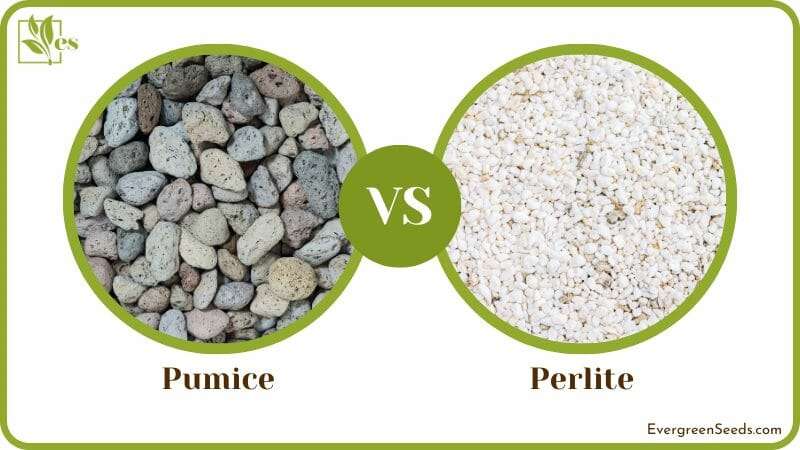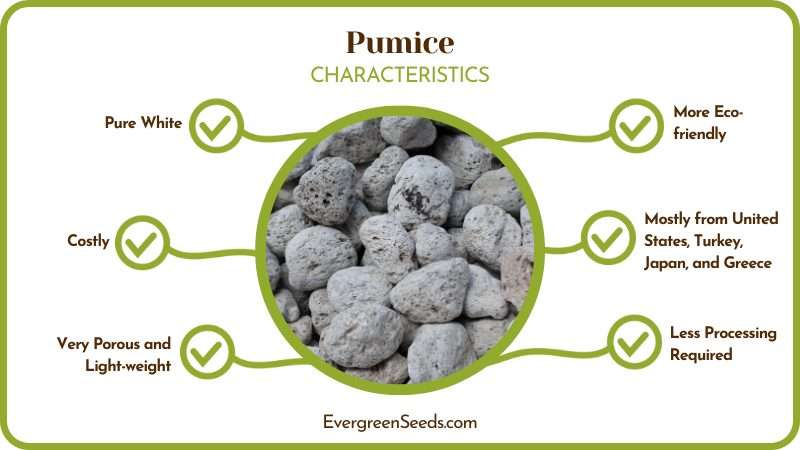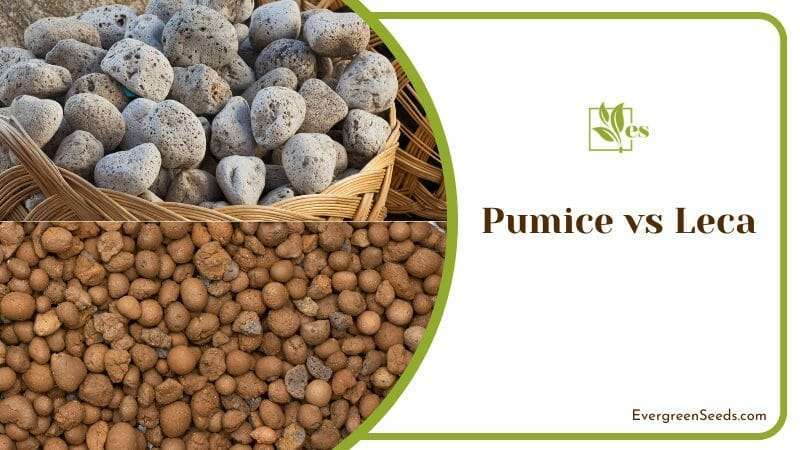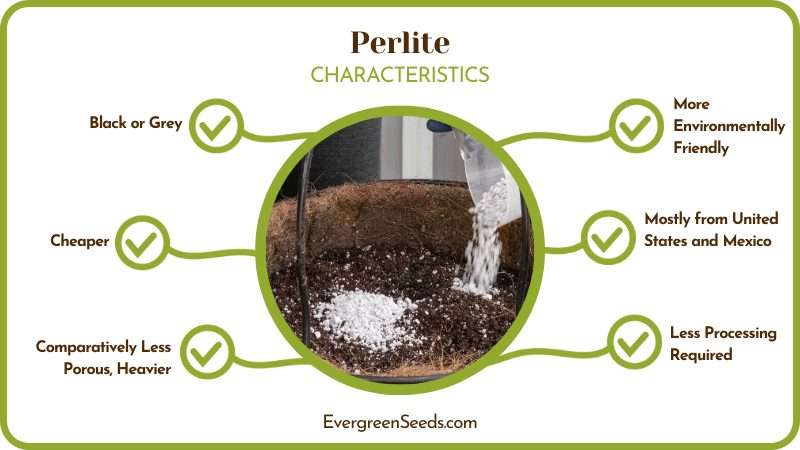Pumice vs Perlite is a critical discussion when deciding how to best improve aeration and drainage for your plants.

Although both are almost equally great at improving your soil, factors like cost, carbon footprint, and porosity differentiate them from each other.
Go through this comparison guide where we have tried our best to help you make an educated decision between these two.
JUMP TO TOPIC
Comparison Table
Let’s take a look at a brief comparison between the two.
| Pumice | Perlite | |
| Color | Pure white | Black or grey |
| Porosity | Very porous and light-weight | Comparatively less porous, heavier |
| Mined From | Mostly from United States, Turkey, Japan, and Greece | United Staes, Mexico |
| Cost | Costly | Cheaper |
| Processing Required | Less processing required | Less processing required |
| Eco-friendly | More eco-friendly | More environmentally friendly |
| Heat required for processing | 1700 degrees Fahrenheit | About 1500 degrees Fahrenheit |
What Is the Main Difference Between Pumice vs Perlite?
The main difference between pumice and perlite is that pumice is white in color, more porous, and more expensive. Perlite, on the other hand, although more easily available everywhere, needs to be processed more and leaves a larger carbon footprint.
What Is Pumice Best For?
Pumice, a volcanic rock mineral widely used in gardening, is a wonder ingredient best used for dramatically improving the soil’s drainage and helping flush out toxins. It is also great for retaining moisture and providing moderate amounts of trace nutrients to the ground.

Read up on these and more benefits in the upcoming paragraphs.
– Improving Water Drainage
Pumice particles loosen up the soil and create pathways for water to flow out of it quickly. Their porosity is very helpful because adequate water drainage is the most important property that a potting soil needs to have. This property prevents water from accumulating in the soil unnecessarily and producing rot and other diseases.
Accumulation of water in the soil almost always leads to a rapid proliferation of rot, causing fungi and bacteria. This extra water is damaging to the plant, too, as it also produces swollen stems and leaves.
Drainage is imperative for another purpose as well: that of flushing out toxins and minerals from the soil every time you water it. These harmful substances are inevitably produced and stay in the ground due to regular fertilizing. Adding pumice will be a great help with flushing them out.
– Retaining Moisture
While pumice does look like a dry rock, tiny microscopic pores on its surface can also absorb water. It has been determined to retain moisture for up to 48 hours straight. Now that is a fantastic property to have for drought-resistant plants like succulents.
When you water soil enriched with pumice, most of the water drains away due to the excellent drainage ability of the pumice amended soil. The water absorbed by the surface of pumice particles is then released slowly back to the soil over time. This is much better for the overall wellness of plants like the Hoya Cumingiana succulent or generally any succulent.
– Providing Much Needed Trace Elements
Pumice is a type of porous volcanic rock, and it is also the source of several precious trace elements. These nutrients’ exact type and composition vary from pumice to pumice, depending on where it is mined from.
Overall, more than 70 different types of trace minerals might be present in it, so it is an excellent additive for enriching cactus soil and other types of household soils.
– Keeping the Soil From Getting Muddy
The pumice stone is an excellent ingredient for soil amendment material. It keeps the water from turning the soil murky and into the mud. This is an essential property as it prevents the soil from harboring rot, causing fungi.
– Being Long Lasting
The best thing about adding pumice to your potting mix is that it is very long-lasting. It doesn’t decompose as it is a mineral. It also doesn’t get root rot, which is a huge plus point when mixing it with succulent soil.
This property of being long-lasting makes their high cost a wise one-time investment. You may have to spend more money to buy it, but it will last a long time.
– Top Dressing the Pot
For those who like to keep ornamental plants, try top dressing your soil with pumice. First, cover the soil with pumice and pour crushed glass or marbles. Pumice will give these marbles true colors and a most pleasing appearance.
– Being Heavier
We can say that pumice is one of the best soil amendments owing to its slightly larger size and heaviness. It usually comes packaged as particles one-third to one-eighth inches in diameter. These are heavy enough and can not be blown away by water and strong air currents, which is a problem you might face with other amendments.
– Superior Soil Additive
Pumice is a far better soil additive than most other commonly-used additives available. Given below is a brief comparison of just a few of these.
– Pumice vs Akadama
Akadama is a soil amending and naturally occurring mineral-like pumice. It is softer and more granular than pumice. It is also lesser-known, more expensive, and harder to buy comparatively. Comparing the property of these two minerals, pumice is stable and does not disintegrate.
Meanwhile, akadama breaks down into smaller particles over time. This increases their water retention capabilities. It also means that it is completely degraded within two to four years and becomes a soggy mass that needs to be replaced.
– Pumice vs Leca
LECA is basically an acronym for lightweight expanded clay aggregate. It comes in hard clay balls that expand when soaked in water. It is used as a growth medium, just like peat moss. It doesn’t contain any nutrients.

Its primary purpose is to loosen the clay up. Its ability to absorb some water and then release it over time is far superior to pumice. It is also better at preventing rot and pest infestations.
Pumice needs to be added to the soil where the plant is potted. Leca has no such requirement — that is why you can skip soil and pot a plant using only Leca.
– Pumice vs Vermiculite
Vermiculite is also a naturally occurring mineral. It is mined chiefly in the United States and South Africa. It has a clay-like and soft texture, unlike pumice, which is a hard rock.
Comparing the properties of these two minerals, pumice has more porosity and, therefore, a better drainage potential. But vermiculite is far superior in retaining moisture compared to pumice soil.
Both of them have different purposes in horticulture. Vermiculite is best suited for tropical plants that need more moisture to grow, whereas orchids and succulents are best developed using pumice as the soil supplement.
What Is Perlite Best For?
Perlite is best for drainage and aeration, and it is also reasonably-priced and comes in three different-sized particles for your convenience. It improves the drainage of soil, increases aeration, and is inexpensive to manufacture. There are three size options to choose from.
Read more in detail ahead.
– Improving the Drainage of Soil
Perlite is used all over the plant world to improve soil’s drainage. Since it is originally a rock and does not integrate with the soil particles, it prevents the soil from getting compacted. This leads to multiple porosities within the soil. Consequently, water easily flows out of such porous soil and out of the drainage hole.
– Increasing Soil Aeration
All the cells that make up a plant need oxygen to grow. While the stems and leaves have it easy to obtain air, the roots often get choked for air in the soil mix.
This is where Perlite comes in and creates little air pockets within the soil. The air now has several passages to pass through and provide oxygen to the plant’s roots.
– Inexpensive Manufacturing
The best thing about Perlite is the fact that it is pretty cost-effective. Currently, the United States is leading the market in its mining and manufacturing. Unlike some other commonly used soil amendments, the perlite manufacturing process is cheaper. It doesn’t end here, as perlite is also readily available almost everywhere.
– Size Options

Perlite is best for having more than one option for the size of particles. The world’s foremost experts working in an organization called the Perlite Insitute determine these sizes. Each particle of Perlite that is manufactured all over the world must fall within three sizes.
Their details are as follows.
– Coarse Perlite
Coarse Perlite has the largest size of particles. Naturally, it is the most porous and with the best-draining properties. Don’t worry, heavy winds can’t blow this away too.
This particle size is best suited for growing succulents. Succulents cannot tolerate water retention in the slightest. Their soil needs chunky materials like coarse Perlite or bark pieces.
Orchids and other epiphytic plants that grow on rocks need Perlite added to their soil. In fact, about 50 percent of their potting medium needs to be this rock.
– Medium-Grade Perlite
This is the middle ground of Perlite between coarse and very fine perlite. Its drainage and aeration properties are also balanced when it comes to drainage and aeration. Medium grade perlite is best suited for seeds and seedlings.
Mix this perlite with compost in a 50:50 ratio to provide the best growth medium ever when planting seedlings. Some seeds that need light to germinate can be covered by a layer of perlite. It allows enough light to reach the seedlings while keeping them covered and moist.
– Fine Grade Perlite
Perlite is also manufactured in very fine-sized particles. These particles are so small as to be easily dispersed by wind or water. This makes them less likely to sink to the bottom of the soil to their advantage. This grade of Perlite is most suited for planting stem and root cuttings by mixing it with sphagnum or peat moss.
– Easily Available Option
Another common reason is that Perlite is more commonly added to the soil for growing plants. It is more readily available to buy or order compared to pumice, coconut coir, or other additives.
– Being Stable
Perlite is an inorganic rock that is relatively stable in nature. No matter how much time passes, it doesn’t disintegrate over time or releases any chemicals into the soil. This makes it a safe, nutrient-rich option to use for your plants. Perlite also has a neutral pH, so it doesn’t affect the pH of the soil to which it is added. So, if you want to use perlite and you need to lower the soil pH, you should also use other ingredients.
– Being Better Than Vermiculite
Both substances have their own merits and demerits when it comes to Vermiculite vs Perlite. While vermiculite has more porosity and water drainage potential, vermiculite is far superior at retaining moisture for longer and making sure the roots aren’t parched for water.
These two are also easy to tell apart; vermiculite is brown or beige in color with a soft texture. As we have discussed, Perlite is a hard rock that is whitish in color.
– Disadvantages of Perlite
There are some disadvantages to Perlite as a fantastic gardening aid as well. The first is that using it sparingly can lead to the soil getting too porous. Often, this leads to the water draining away too quickly, and the plant eventually becomes dehydrated.
Perlite is a relatively lightweight material, and its dust has been known to irritate the eyes and the throat. People with respiratory problems are especially prone to exacerbation as a consequence.
It is a non-renewable resource, and even if it is slightly more energy-efficient than other soil substrates, only a limited amount is available.











